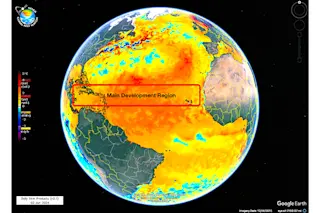The much anticipated 2024 Atlantic hurricane season is here, and with ocean heat setting records, plus a looming La Niña, it may well take an appalling toll.
Tropical cyclones are fueled by oceanic heat, and right now, the gas tank is overflowing.
As University of Miami tropical cyclone expert Brian McNoldy posted to social media the other day, "It's June 1, the first day of Atlantic #HurricaneSeason, and the ocean heat content averaged in the Main Development Region is as high as it normally would be on August 17. And incredibly, it's even higher than what 2023 was on this date."
Last year at this time, the oceanic heat was already incomprehensibly high.
Ocean heat content in the main development region for Atlantic hurricanes, as of June 4, 2024. (Credit: Brian McNoldy)
Brian McNoldy
Record high oceanic heat also is an issue in the Gulf of Mexico, and in the ...














